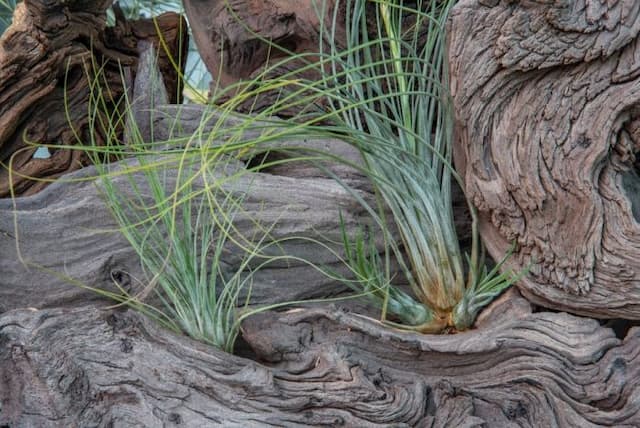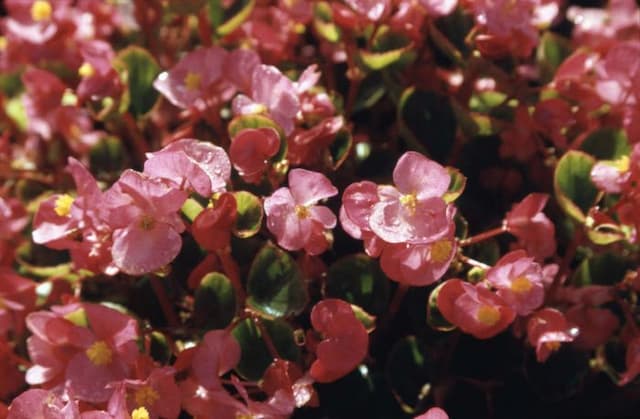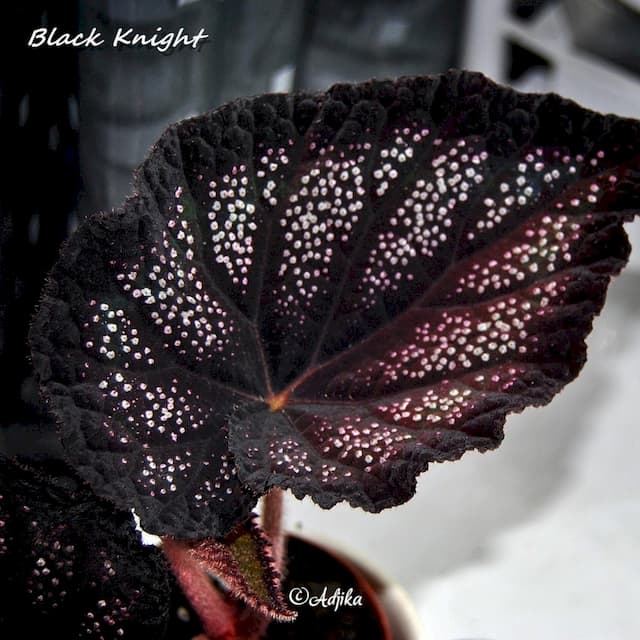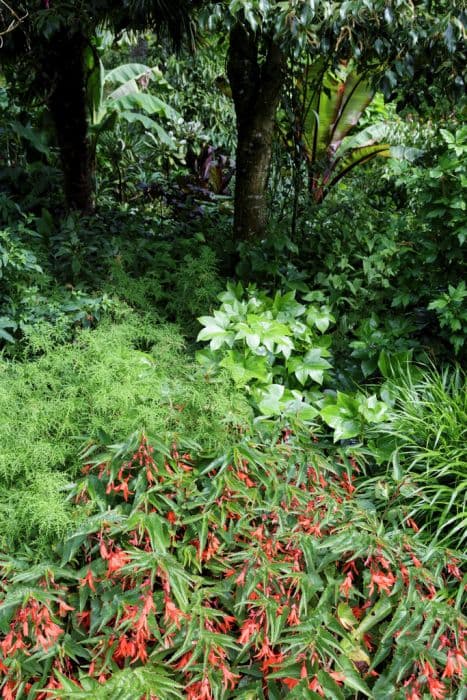Wax Begonia Begonia 'David Blais' (R)

ABOUT
Begonia 'David Blais' is a strikingly beautiful plant, with its appearance characterized by vibrant foliage and remarkable blooms. It has a lush, bushy growth habit, presenting a dense cluster of leaves and flowers. The leaves of this particular Begonia are unique and elegant; they typically display a range of colors from deep green to shades of red and bronze. These leaves are often asymmetrical, with an intricate pattern of veins and sometimes a slightly puckered surface that catches the light to add to their attractiveness. The flowers of Begonia 'David Blais' are one of its most captivating features. They bloom in clusters, with each individual flower showcasing delicate petals that can range from soft pinks to rich, warm reds. The petals may be smooth or edged with delicate frills, adding to their overall charm and sophistication. Both the leaves and the flowers are borne on stems that can be either upright or gently trailing, depending on the support provided and the growing conditions. The contrast between the foliage and the blooms creates a vibrant display, making the 'David Blais' variety a popular choice for gardeners seeking a pop of color and texture in their flower beds or containers. This Begonia variety can also develop a lush undergrowth of smaller leaves that fill in the space around the stems, contributing to the fullness of the plant's overall appearance. When well-cared for and thriving, Begonia 'David Blais' is a spectacular addition to any plant collection, bringing with it a sense of drama and natural beauty.
About this plant
 Names
NamesFamily
Begoniaceae
Synonyms
There are no widely recognized common names distinct for the hybrid Begonia 'David Blais' as it is typically referred to by its cultivar name.
Common names
Begonia 'David Blais' (R).
 Toxicity
ToxicityTo humans
Begonias, including the Begonia 'David Blais', can be mildly toxic to humans if ingested. Ingesting parts of the plant may cause irritation of the mouth, lips, throat, and can lead to difficulty swallowing, nausea, vomiting, and salivation. It is important to keep begonias out of the reach of small children who may accidentally consume the plant parts.
To pets
Begonias, including the Begonia 'David Blais', are also toxic to pets such as dogs and cats. If a pet ingests this plant, it may experience symptoms such as oral irritation, excessive drooling, vomiting, and difficulty swallowing. It is crucial to prevent pets from chewing on or ingesting any part of these plants to avoid these adverse reactions.
 Characteristics
CharacteristicsLife cycle
Perennials
Foliage type
Deciduous
Color of leaves
Varied
Flower color
Mixed
Height
1-2 feet (30-60 cm)
Spread
1-2 feet (30-60 cm)
Plant type
Herb
Hardiness zones
10
Native area
Central America
Benefits
 General Benefits
General Benefits- Decorative Appeal: Begonias are known for their attractive foliage and flowers, adding aesthetic value to gardens and indoor spaces.
- Versatility: Being adaptable to a variety of growing conditions, they can thrive in both garden beds and containers.
- Low Maintenance: They generally require minimal care, making them suitable for busy gardeners or those with limited horticultural experience.
- Shade Tolerance: Begonias are well-suited for shaded areas where other plants might struggle to grow.
- Drought Tolerance: Some begonias are able to withstand periods of dryness, once established, reducing the need for frequent watering.
- Pest Resistance: Certain varieties of begonias are resistant to pests, reducing the need for chemical insecticides.
- Long Blooming: Begonias often have a lengthy flowering period, providing color and interest throughout the growing season.
- Seasonal Flexibility: Various begonias are suited for different seasons, with some blooming in summer while others in fall.
- Propagation Ease: Begonias can be easily propagated from leaf cuttings, making it simple to expand your collection or share with others.
 Medical Properties
Medical PropertiesThis plant is not used for medical purposes.
 Air-purifying Qualities
Air-purifying QualitiesThis plant is not specifically known for air purifying qualities.
 Other Uses
Other Uses- Photography Prop: Begonias, with their vibrant colors and diverse leaf patterns, can serve as a striking subject or background in macro and nature photography.
- Artistic Inspiration: The unique features of the Begonia can inspire designs in various art forms ranging from paintings to textile patterns.
- Culinary Garnish: Some Begonias have edible flowers that can be used as a decorative, colorful garnish for salads and desserts (though it's important to ensure they are free from pesticides and safe for consumption).
- Education: Begonias can be used in educational settings to teach botany, especially topics related to hybridization, propagation, and plant care.
- Stress Relief: Caring for Begonias and other plants can provide a form of horticultural therapy, helping people to relax and reduce stress.
- Fashion Accessories: Begonia blossoms can inspire or be incorporated into fashion accessories such as hair pins or brooches.
- Event Decorations: With their showy appearance, Begonias can be used to create natural, elegant arrangements for weddings or other events.
- Crafting: Dried Begonia flowers and leaves can be used in crafting for making bookmarks, greeting cards, or pressed flower art.
- Collectibles: Some plant enthusiasts collect different varieties of Begonias as a hobby, appreciating the uniqueness of each hybrid.
- Seasonal Displays: Begonias can be included in seasonal indoor or outdoor displays, particularly in spring and summer, to add color and interest to the decor.
Interesting Facts
 Feng Shui
Feng ShuiThe plant Begonia is not used in Feng Shui practice.
 Zodiac Sign Compitability
Zodiac Sign CompitabilityThe plant Begonia is not used in astrology practice.
 Plant Symbolism
Plant Symbolism- Caution - Begonia often symbolizes caution or a warning to be careful in new situations due to its delicate and intricate form.
- Individuality - The Begonia 'David Blais' with its unique colors and patterns stands for uniqueness and encourages embracing one's own individuality.
- Harmony - With its balanced growth and symmetrical leaves, begonias can represent harmony in the natural world and in human relationships.
- Gratitude - Giving Begonia plants is traditionally associated with feelings of gratitude and appreciation towards another person.
 Water
WaterFor your Begonia 'David Blais', commonly known as the Dragon Wing Begonia, you should maintain a consistent watering schedule to keep the soil evenly moist but not waterlogged. Water the plant when the top inch of the soil feels dry to the touch, typically once every week, but this may vary depending on the humidity and temperature of your environment. A rough estimate is to use about 16 ounces of water for a 6-inch pot. Avoid letting the begonia sit in water by ensuring good drainage, and never water directly on the leaves to prevent fungal diseases.
 Light
LightDragon Wing Begonias flourish in bright, indirect light. They should be placed in a spot that receives filtered sunlight, as direct sun can scorch their leaves. East or west-facing windows are ideal locations for these plants, providing a few hours of morning or evening sun without the harsh midday rays.
 Temperature
TemperatureDragon Wing Begonias thrive best in temperatures between 60 and 75 degrees Fahrenheit. They can tolerate a minimum temperature no lower than 50 degrees Fahrenheit and a maximum up to about 86 degrees Fahrenheit, though prolonged exposure to the extremes may harm the plant. The ideal range provides a warm and stable environment, mimicking their natural tropical habitat.
 Pruning
PruningPruning Dragon Wing Begonias encourages bushier growth and removes unhealthy leaves or stems. Prune as needed, particularly when the plant becomes leggy or after a flush of blooms is spent. The best time for heavy pruning is in the spring before the new growth starts. Regularly deadheading the spent blooms will promote more flowering.
 Cleaning
CleaningAs needed
 Soil
SoilThe best soil mix for the Wax Begonia is light, well-draining, and rich in organic matter with a pH of 5.5 to 6.5. A mix of peat, perlite, and compost works well to maintain the necessary balance of moisture and air circulation.
 Repotting
RepottingWax Begonias should be repotted every 1-2 years to ensure the soil remains nutrient-rich and to prevent root-bound conditions. Repot during the spring or early summer.
 Humidity & Misting
Humidity & MistingWax Begonias thrive in moderate to high humidity environments; aim for a humidity level between 50% and 70% for optimal growth.
 Suitable locations
Suitable locationsIndoor
Provide bright, indirect light and ensure good air circulation.
Outdoor
Partial shade with morning sun and shelter from harsh elements.
Hardiness zone
10-11 USDA
 Life cycle
Life cycleThe life cycle of Begonia 'David Blais' (R), commonly known as Begonia, begins with seed germination, where environmental factors such as temperature, light, and moisture trigger the growth of a new plant. Next, the seedling transitions into a juvenile phase, developing a root system and first true leaves, establishing the foundation for later growth. As it enters the vegetative stage, the Begonia experiences rapid leaf and stem growth, expanding its foliage through photosynthesis and branching. The plant then advances to the reproductive stage, where it produces flowers capable of self-pollination or cross-pollination with other Begonia plants, leading to the formation of seeds for future generations. Following pollination, seed development ensues; once seeds mature, they are dispersed, completing the life cycle. After reproduction, individual plants may eventually reach senescence, where growth slows, and the plant may die, although many Begonias can live for several years with proper care.
 Propogation
PropogationPropogation time
Spring-Early Summer
The Begonia 'David Blais', commonly known as Begonia, is often propagated through stem cuttings, a popular method that can be initiated during its active growing season, typically from spring to early summer. To propagate through stem cuttings, a healthy stem with a few leaves is snipped just below a node using a clean, sharp pair of scissors or a knife. The cutting, about 3-4 inches (approximately 7.5-10 cm) long, is then placed in a mixture of moist potting soil and perlite or vermiculite to encourage root development. Sometimes, leaves are removed from the lower part of the cutting to reveal a clean section of stem which is then inserted into the rooting medium. The pot is kept in a warm, well-lit space without direct sunlight, and the soil moisture is maintained but not waterlogged, creating a conducive environment for rooting. Roots typically begin to form within a few weeks, after which the new Begonia plant can be gradually acclimatized to normal growing conditions.


![Begonia [Allure]](/_next/image?url=https%3A%2F%2Fplants-admin.emdemapps.com%2Fimages%2Fplants%2F%2Fimages%2F604b5b9006ab9.png&w=640&q=75)






